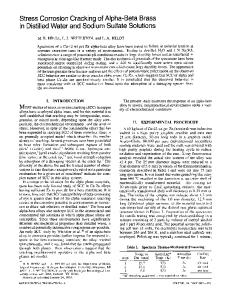The influence of deformation path on the slow strain-rate stress corrosion cracking of admiralty brass sheet
- PDF / 1,453,260 Bytes
- 6 Pages / 594 x 774 pts Page_size
- 65 Downloads / 275 Views
I.
INTRODUCTION
ADMIRALTY brass is used extensively as tubing in heat exchanger systems where under certain conditions it is susceptible to stress corrosion cracking (SCC) which may be intergranular or transgranular. 1 Transgranular SCC of Admiralty metal as well as alpha-phase Cu-Zn alloys is characterized by cleavage-like fracture s u r f a c e s , 2-7 crack growth which is dependent on stress intensity, 5'6'7 and a loss of ductility in slow strain-rate tests. 9 Like most SCC studies, the previous research on the SCC of the Admiralty metal has relied on either simple uniaxial tension, the presence of an undetermined residual stress state, or the multiaxial stress state which exists locally at a crack tip. Thus, our present understanding of the influence of stress or strain state is limited not only for the specific case of transgranular SCC of Admiralty brass but also for SCC of metals in general. The purpose of this research is to examine, by the slow strain-rate method, the transgranular SCC of Admiralty brass sheet subjected to the nearly complete range of multiaxial deformation conditions associated with thinning of the sheet. The test technique is new, and as described elsewhere, ~~ it relies on measurements of the strain state at failure as determined locally from - 1 mm grids. These results form a fracture limit diagram which identifies a strain criterion for fracture over the range of loading paths from uniaxial tension to equibiaxial tension. When combined with crack growth measurements and fractographic observations, these data form a basis for understanding the influence of deformation path on SCC under slow strainrate conditions. For the sake of experimental simplicity, the study is based on the SCC of Admiralty brass at room temperature in a 0.1M CuSO4 solution at open circuit potential. W.K. BLANCHARD, Jr., Graduate Research Assistant, D. A. KOSS, Professor, and L.A. HELDT, Professor and Head, are all with the Department of Metallurgical Engineering, Michigan Technological University, Houghton, MI 49931. Manuscript submitted September 19, 1983.
METALLURGICALTRANSACTIONS A
II.
EXPERIMENTAL PROCEDURE
The material used in this investigation was arsenicinhibited Admiralty brass, alloy C44300 with compositions (wt pct) in the range of 70.9 to 71.8 pct Cu, 28.2 to 27.1 pct Zn, 1.0 to 0.8Sn, and 0.02 to 0.10As. All specimens were tested in the fully annealed condition and had average grain size of 30 to 35 /zm. The material was in the form of either 1.25 mm thick sheet or 6.25 mm plate with a gauge thickness machined to 1.25 mm. The test method depends on imposing nearly the complete range of deformation paths which result in sheet thinning, and it is described in detail elsewhere. ~0Basically, the method consists of slow strain-rate tests of three different specimen configurations: uniaxial tension, plane-strain tension, and equibiaxial tension. The gauge section, being of sheet thickness, deforms in plane stress. Most of the tests were performed at an equivalent strain rate of - 8 • 10 -6 s -1. The
Data Loading...











